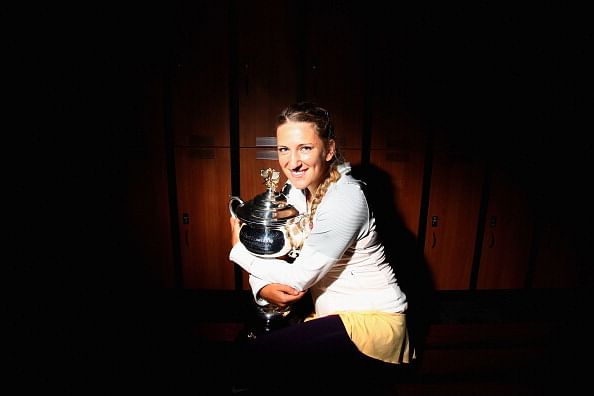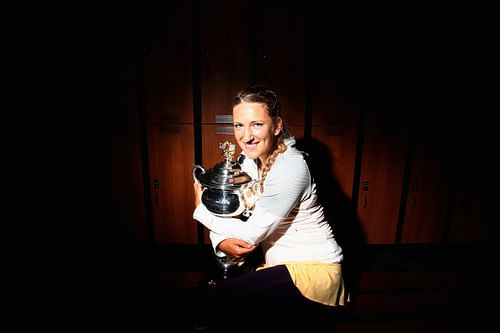
Azarenka's grit turns negatives into positives in win over Li

No matter how many problems you may have, they disappear the moment you win. Winning solves everything. That’s what we’ve come to learn, anyway. But does it really solve everything? Going into today’s Australian Open final against Li Na, Victoria Azarenka had been besieged by a world of troubles. She was not the crowd favorite (to put it mildly), she had had her sportsmanship spirit questioned vociferously over the previous two days, and she was in danger of giving up her coveted No. 1 spot. And how many of those problems disappeared after she prevailed 4-6, 6-4, 6-3 to clinch the title? Only one of them – the ranking one – did.
Azarenka started the match looking like she was weighed down by all the negative air surrounding her. She made uncharacteristic errors, rolled in soft second serves (up to the seventh game she hadn’t won a single point on her second serve) and generally looked intensely uncomfortable on the court. Li, on her part, was making her fair share of errors too, but she was managing to off-set some of them with her sweetly-timed winners. Her forceful groundstrokes seemed to be edging out Azarenka’s laboured gets, and after eight tumultuous games, Li served for the first set at 5-3. But that’s when Azarenka sprang to life, coming up with a string of strong returns to get back on serve. It looked like she had calmed her nerves, and was ready to turn the contest into the quality battle of offense against defense that it had promised to be before the start. But no; she continued to spray errors all over the court, and her serve continued to be punished by a rampaging Li, who broke once again to win the set 6-4.
The start of the second set seemed like the moment of truth for both players. For Azarenka, it was a chance to show that she was made of strong stuff; that she wasn’t going to let lack of crowd support (every one of Li’s winners was cheered with roars of delight, while Azarenka’s winners were mostly met with stony silence) come in the way of her performance. For Li, it was a chance to show that her newfound consistency – her pre-Rodriguez tendency to let one error turn into an avalanche of them had been largely absent this tournament – was for real. As it turned out, both players failed to rise to the challenge, but they didn’t completely shrink away from it either. Li kept going for her shots, kept missing quite a few of them, but still kept putting pressure on her opponent with her first-strike tennis. And Azarenka kept making errors, but also started getting just enough balls back to elicit a few more errors from Li. The Belarussian raced off to 3-0 in the second set, but the lead never looked likely to last long. Sure enough, Li got one of the breaks back immediately, and seemed to have regained the advantage in the rallies, with her smooth backhand doing a lot of damage.
The match didn’t lack drama, but it was surprisingly short on game-changing moments. When Li tumbled to the court after twisting her ankle while trying to change direction at 1-3, 30-30, it looked like a turning point; it seemed likely that Azarenka was going to run away with the match from there. But Li came back from her medical timeout strongly, and in almost no time the set was level at 4-4. You’d have thought that that was the definitive momentum-shifting moment, but again, it wasn’t. As Li stepped up to serve at 4-4, with the chance to get within one game of winning the match in her grasp, her old erroneous ways returned with a vengeance. She threw away the game through a bunch of loose shots, and Azarenka didn’t blink when given the chance to serve for the set.
With the match tied at one-set all, Azarenka seemed to have turned the tide in her favor for good, and that idea was reinforced when she got the early break in the third set. This trend turned out to be short-lived too, though: Li broke back immediately, and then held for a 2-1 lead. And just when Li seemed to have regained her consistency, disaster struck once again – she had another ugly slip while attempting a down-the-line backhand, and this time hit her head on the court too. The trainer spent a good deal of time trying to gauge whether Li had suffered any concussion, and after a series of discussions the Chinese returned to the service line, her disarming smile firmly in place. However, this second injury seemed to have shaken Li more than she let on; she showed no obvious discomfort while moving, but her error count shot up even higher after the incident. She gave up the break in the very next game, and never really recovered. Azarenka broke once more at 5-3, predictably off a Li error, and the championship was hers for the second consecutive year.
Listening to the noise in the stadium, though, you wouldn’t have been able to tell that the match had ended. The crowd, still obviously anti-Azarenka, voiced only half-hearted applause for the champion. Azarenka broke into tears the moment Li’s last shot went sailing beyond the baseline, and she kept crying as she went up to her support team (which included LMFAO singer Redfoo). But the spectators in the arena weren’t won over even by this supposedly heart-tugging show of emotion.
As the presentation ceremony unfolded, Li continued to garner the biggest roars. She has been a wildly popular player in Australia for a while now, and while her runner-up speech wasn’t littered with smart jokes and witty one-liners as her interviews usually are, it sounded genuine and gracious. The tournament as a whole has to be seen as a success for Li. She did make an ungodly 57 errors in the final, and succumbed to her nerves at the most inopportune of moments, but her tennis remained steady and clean for the major part of the fortnight, which is longer than anybody would have expected. Her semifinal shellacking of Maria Sharapova was particularly eye-opening; if she can sustain that kind of level for any reasonably stretch of time, she will likely have many more opportunities to contest for Slam titles, despite being on the wrong side of 30.
Azarenka, meanwhile, will leave Australia as the champion and World No. 1 for the second year running, even if her journey this time was considerably less joyful than the last. Right from her 3rd round struggle against Jamie Hampton (who also, incidentally, got injured after winning the first set) to her questionable timeout against Sloane Stephens in the semifinal, it was never a smooth ride for the Belarussian. She had to really fight for this one; she had to claw, scratch and hustle her way to the finish line, and even when she did, her triumph was met with a response that was only half as loud as her grunts.
Azarenka’s 2013 Australian Open campaign was anything but pretty. But if there’s one thing we’ve learned about her in the past year, it is that she doesn’t have a particular desire to keep things pretty. Azarenka’s desire has only one target – victory – and she makes it a point to expend every last ounce of her strength and her determination to reach there, no matter how unlikable she may come off in the process.
Winning didn’t solve all of Azarenka’s problems today. But should we really care about that? Azarenka certainly doesn’t.